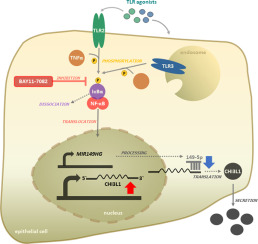当前位置:
X-MOL 学术
›
Cell. Signal.
›
论文详情
Our official English website, www.x-mol.net, welcomes your feedback! (Note: you will need to create a separate account there.)
NF-κB-mediated inhibition of microRNA-149-5p regulates Chitinase-3-like 1 expression in human airway epithelial cells.
Cellular Signalling ( IF 4.8 ) Pub Date : 2019-12-16 , DOI: 10.1016/j.cellsig.2019.109498 Kathleen Hübner 1 , Diana Karwelat 1 , Emma Pietsch 1 , Isabell Beinborn 1 , Sarah Winterberg 1 , Katrin Bedenbender 1 , Birke J Benedikter 2 , Bernd Schmeck 3 , Evelyn Vollmeister 1
Cellular Signalling ( IF 4.8 ) Pub Date : 2019-12-16 , DOI: 10.1016/j.cellsig.2019.109498 Kathleen Hübner 1 , Diana Karwelat 1 , Emma Pietsch 1 , Isabell Beinborn 1 , Sarah Winterberg 1 , Katrin Bedenbender 1 , Birke J Benedikter 2 , Bernd Schmeck 3 , Evelyn Vollmeister 1
Affiliation

|
Lower respiratory tract infections are among the most common causes of death worldwide. Main pathogens leading to these severe infections are viruses and gram-positive bacteria that activate toll-like receptor (TLR)-mediated immune responses via pathogen-associated molecular patterns. One protective factor induced during infection is Chitinase-3-like 1 (CHI3L1), which exerts various functions, e.g. in host cell proliferation and bacterial counteraction, and has been proposed as a biomarker in several acute and chronic inflammatory conditions. MicroRNAs (miR) have become important regulators of inflammation and infection and are considered therapeutic targets in recent years. However, it is not known whether microRNAs play a role in the regulation of CHI3L1 expression in TLR-mediated respiratory epithelial cell inflammation. In this study, we analysed the pre- and post-transcriptional regulation of CHI3L1 by TLRs in bronchial epithelial cells. Therefore, we stimulated BEAS-2B cells with the bacterial TLR2-ligand lipoteichoic acid or the viral dsRNA analogue poly(I:C). We observed an increase in the expression of CHI3L1, which was dependent on TNF-α-mediated NF-κB activation in TLR2- and TLR3-activated cells. Moreover, TLR2 and - 3 stimulation caused downregulation of the microRNA miR-149-5p, an effect that could be suppressed by inhibiting NF-κB translocation into the nucleus. Luciferase reporter assays identified a direct interaction of miR-149-5p with the CHI3L1 3´untranslated region. This interaction was confirmed by inhibition and overexpression of miR-149-5p in BEAS-2B cells, which altered the expression levels of CHI3L1 mRNA. In summary, miR-149-5p directly regulates CHI3L1 in context of TLR-mediated airway epithelial cell inflammation and may be a potential therapeutic target in inflammation and other diseases.
中文翻译:

NF-κB介导的microRNA-149-5p抑制作用可调节人气道上皮细胞中几丁质酶3样1的表达。
下呼吸道感染是全世界最常见的死亡原因之一。导致这些严重感染的主要病原体是病毒和革兰氏阳性细菌,它们通过病原体相关的分子模式激活通行费样受体(TLR)介导的免疫反应。感染期间诱导的一种保护因子是几丁质酶-3样1(CHI3L1),它在宿主细胞增殖和细菌抵抗中发挥多种功能,并已被提议在几种急性和慢性炎症条件下用作生物标志物。MicroRNA(miR)已成为炎症和感染的重要调节剂,近年来被认为是治疗靶标。但是,尚不清楚microRNA是否在TLR介导的呼吸道上皮细胞炎症中对CHI3L1表达的调节中发挥作用。在这项研究中,我们分析了支气管上皮细胞中TLRs对CHI3L1的转录前和转录后调控。因此,我们用细菌TLR2-配体脂蛋白酸或病毒dsRNA类似物poly(I:C)刺激BEAS-2B细胞。我们观察到CHI3L1的表达增加,这取决于在TLR2和TLR3激活的细胞中TNF-α介导的NF-κB的激活。此外,TLR2和-3刺激引起microRNA miR-149-5p的下调,这种作用可以通过抑制NF-κB移位进入细胞核来抑制。萤光素酶报告基因分析鉴定了miR-149-5p与CHI3L1 3'非翻译区的直接相互作用。这种相互作用通过在BEAS-2B细胞中抑制和过度表达miR-149-5p来证实,这改变了CHI3L1 mRNA的表达水平。总之,
更新日期:2019-12-17
中文翻译:

NF-κB介导的microRNA-149-5p抑制作用可调节人气道上皮细胞中几丁质酶3样1的表达。
下呼吸道感染是全世界最常见的死亡原因之一。导致这些严重感染的主要病原体是病毒和革兰氏阳性细菌,它们通过病原体相关的分子模式激活通行费样受体(TLR)介导的免疫反应。感染期间诱导的一种保护因子是几丁质酶-3样1(CHI3L1),它在宿主细胞增殖和细菌抵抗中发挥多种功能,并已被提议在几种急性和慢性炎症条件下用作生物标志物。MicroRNA(miR)已成为炎症和感染的重要调节剂,近年来被认为是治疗靶标。但是,尚不清楚microRNA是否在TLR介导的呼吸道上皮细胞炎症中对CHI3L1表达的调节中发挥作用。在这项研究中,我们分析了支气管上皮细胞中TLRs对CHI3L1的转录前和转录后调控。因此,我们用细菌TLR2-配体脂蛋白酸或病毒dsRNA类似物poly(I:C)刺激BEAS-2B细胞。我们观察到CHI3L1的表达增加,这取决于在TLR2和TLR3激活的细胞中TNF-α介导的NF-κB的激活。此外,TLR2和-3刺激引起microRNA miR-149-5p的下调,这种作用可以通过抑制NF-κB移位进入细胞核来抑制。萤光素酶报告基因分析鉴定了miR-149-5p与CHI3L1 3'非翻译区的直接相互作用。这种相互作用通过在BEAS-2B细胞中抑制和过度表达miR-149-5p来证实,这改变了CHI3L1 mRNA的表达水平。总之,


























 京公网安备 11010802027423号
京公网安备 11010802027423号